When the Polish troops settled in Kiev, the Bolsheviks immediately began to prepare for the attack. The soldiers of the Polish Army were ready to defend themselves to the last drop of blood. They did not know, however, that on the northern front, on Berezina, they would have to fight ... also with their compatriots.
Among the fighters with the nascent Republic of Poland for workers and peasants' justice were representatives of many nationalities. In addition to the Chinese, Germans, Latvians, Finns and Ukrainians, there were also Poles. Under the conditions of the war fratricidal clashes could not be avoided. In 1919, they happened quite often. The Regiments of the Western Polish Rifle Division clashed with Polish cavalry and infantrymen at Lida, Baranowicze and Vilnius.
When on June 9, 1919 the unit was renamed the 52nd Rifle Division and lost its national character, Polish-Polish meetings became less frequent. But they still happened. The most brutal and bloody of them took place on May 23, 1920 at Berezina.
Counteroffensive
Even when the Polish Army was approaching Kiev, Włodzimierz Lenin turned to the Red Army soldiers marching to the front against Poland. He mobilized them to a decisive fight against the "Polish landowners and capitalists":
Now we say:comrades, we were able to dismiss a more terrible enemy, we were able to defeat our own landowners and capitalists - we will also defeat the Polish landowners and capitalists! We should all take an oath here today, make a solemn promise that we will all stand as one man to prevent the victory of Polish lords and capitalists.
Long live the peasants and workers of a free, independent Polish republic! Down with Polish lords, landlords and capitalists! Long live our workers and peasants' Red Army!
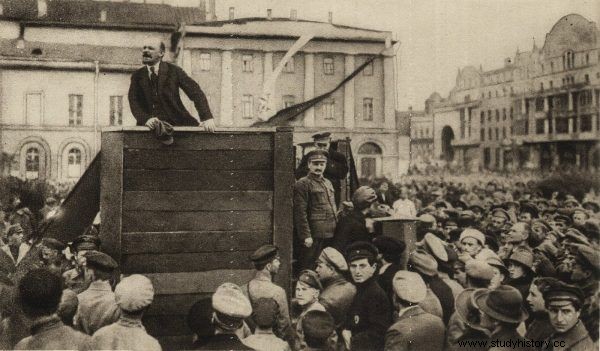
In the spring of 1920, Włodzimierz Lenin encouraged the Red Army to fight ruthlessly against "Polish landowners and capitalists" (illustrative photo).
The purpose of the upcoming meals was to reject Poles from Ukraine and open the road to the west, to Warsaw, and then to Berlin . On May 14, 1920, Tukhachevsky's army was the first to move to Belarus. The commander wanted to relieve his own armies fighting in the south with a quick and not fully prepared counteroffensive and at the same time "to smash and throw the Polish army into Pinskin mud".
After two weeks of offensive, Soviet troops advanced 150 kilometers deep into Polish positions, creating a wide arc facing southwest. On the second wing of the "Smolensk gate", by Berezina, the 16th Army was ordered to cross the river and attack the towns of Berezina and Dokshyce. If successful, this move would cut off the Polish armies on the Lithuanian-Belarusian Front from the southern flank, which fought along the Dnieper and at the mouth of the Soża.
In the first phase of the operation, the Red Guards intended to occupy strategic locations on the Berezina River. There, they wanted to prepare rear bases for the Berezyń Division of the Dnieper Navy Flotilla. His ships not only provided supplies, but also supported the guns that were attacking with fire. The regiments of Soviet riflemen were also supported by a landing unit, consisting of Polish Bolsheviks.
On the other side of the river
The 64th Grudziądz Infantry Regiment stood in front of the Soviet army. It was a relatively young unit, which began to be formed on August 16, 1919 in Inowrocław from Pomeranian volunteers. From the beginning of 1919, they crossed the German border to join the ranks of the Polish Army in Greater Poland . Initially, the regiment consisted of one infantry battalion, an independent company and a staff. In January 1920, he was joined by the Murmansk Battalion, famous for fighting the Bolsheviks in the far north of Russia.
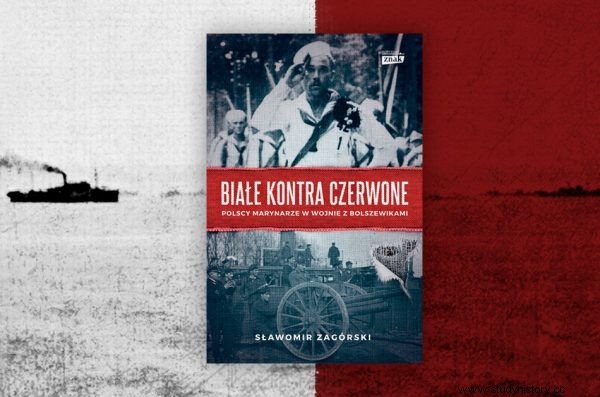
The war struggles on the rivers of the Eastern Borderlands, full of surprising twists and turns, in Sławomir Zagórski's book "White versus red" (Znak Horyzont 2018).
At that time, soldiers wore German uniforms with the collars of the former coat of arms of the Malbork Province - a red eagle on a golden shield. When the unit was expanded to a full three-battalion composition, with all services, it was sent to Kashubia, on the border with Germany. The boring border service lasted three months.
Finally, on April 30, 1920, the regiment set off with the 63rd Toruń infantry regiment to Łuniniec. The first battle of Pomeranian soldiers fought on May 8 near Jełan. Then, following the retreating enemy, they reached Berezina. They captured Horwal, in which the sappers regiment established a bridgehead. Then, in cooperation with the engineers of the Pinsk Flotilla, they began repairs of captured steamships.
To keep the enemy in suspense and to speak out, the foot soldiers sent patrols across the front lines every night. They directed them mainly to the vicinity of the village of Wielka Olba, where the Soviets were gathering supplies in preparation for the next phase of the offensive. On May 24, they were able to see for the first time what a brutal enemy they had in front of them. As Colonel Konrad Rogaczewski wrote in the chronicle of the 64 Grudziądz regiment:
On May 24, 1920, a patrol of the same company with a force of 12 privates sent to Big Olba found no enemy there. On the way back, the patrol was ambushed and crashed. Only one private survivor who managed to escape from captivity. It turned out that the patrol took the same path as the march forward, and the enemy managed to trap him. The sent pursuit was no longer able to catch up with the enemy to rescue the captives.
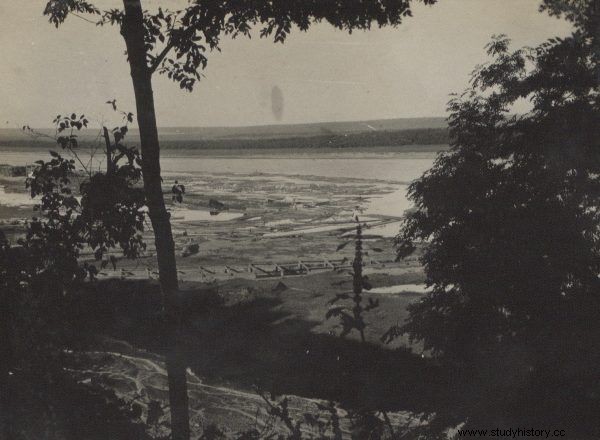
Berezine in the photo from 1915. Five years later, fierce battles between the soldiers of the Polish Army and Polish Red Army soldiers took place on the river.
At that time, the command did not know that they had to fight the red Poles.
Another patrol sent to the Soviet rear that same night was more fortunate and even captured the prisoners. In the morning, they testified that an attack on Polish positions was being prepared, located near Szyrchówka, Wielka Olba and Wittówka. The gunners were ordered to capture Horwal and the bridge, which was built by a technical platoon in early May.
Indeed, in the early morning the ships of the Soviet flotilla landed the announced landing against the 4th company of the 64th Regiment. Then two armed ships approached the village, opening fire. The four others started firing at the infantry positions, preparing the field for the assault of the shooters.
"Come goddamn bayonets"
The missiles of the Soviet ships burst into the swampy, wet trenches, showering our walkers with clumps of grass, stones and mud . Pomeranians encountered such a strong artillery fire for the first time. The fire from the gunboats "Gromovoj", "Goriaczyj", "Gromkij" and the caretaker literally choked them to the ground. At that time, the landing company was slowly approaching Polish positions. As Rogaczewski later reported:
It was the first time that a battalion with an enemy bayonet attack was encountered here. As it turned out later, it was a regiment of Polish communists. "Me Antek, you Antek - come bloody bayonets" With this and the like cries the troops engaged with each other. The enemy had already begun to give way when, through the marshy forest, on the flank of the 4th company, a strong Soviet unit ran into it, which tipped the tide of victory in favor of the enemy. Kompanja, surrounded by an enormous advantage on three sides, fought to the point of death.
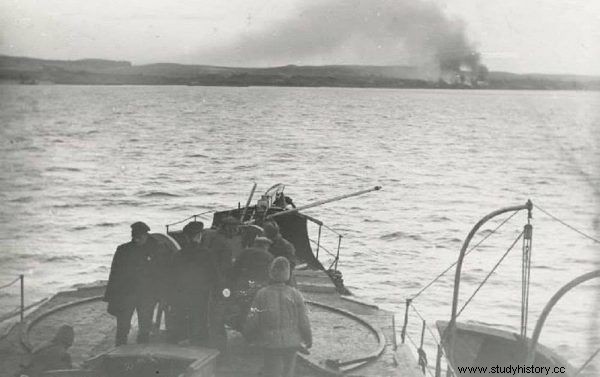
The fire of the Soviet gunboats pinned the Polish soldiers. Illustrative photo from the book "White versus Red".
Both sides fought without mercy. I described the battle fought for life and death in the book "White versus Red. Polish sailors in the war against the Bolsheviks ” :
Despite heavy artillery fire, the infantrymen did not give up while being surrounded. The company commander, 2nd Lt. Prabucki; platoon commander, Sgt. Marian Butkiewicz and almost the entire company. The footmen defended themselves in a circle, fending off the fierce attacks of the "raiders" and stabbing blindly with bayonets.
The communists did not owe them. Bodies swirled, blood was shed, curses and curses were heard. A Pole fought against a Pole. As brutal as possible. Only the brigade's reserve, supported by artillery fire, rejected the flotilla's landing force.
The battlefield was a frightening sight. “On the corpse of Second Lieutenant Prabucki lay the corpse of the sergeant, on them the corporal, on the corpses of the entire team. This is how a Pomeranian soldier died in defense of the common motherland, although perhaps he did not speak Polish well yet, ”described Rogaczewski sadly. "All the fallen had red eagles (regimental badge) pierced several times and pinned to their necks with bayonets."
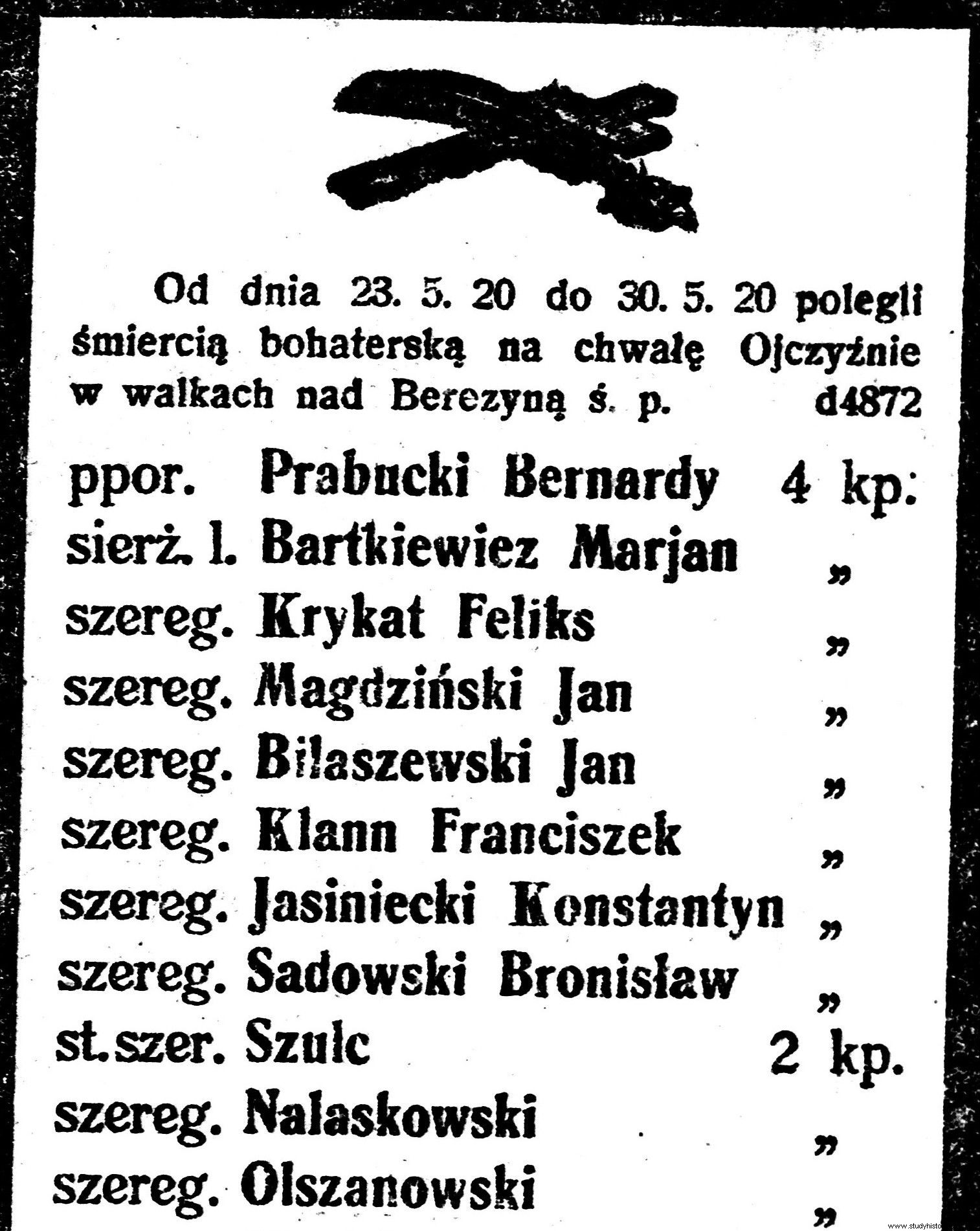
In the fierce battle with the Bolsheviks, among others, the commander of the 4th campaign, Lieutenant Prabucki, was killed. The picture shows the obituary in Kurjer Poznański. Sergeant Butkiewicz's name was twisted on it.
Subsequent strikes of the reserve units resulted in the rejection of the landing into the river, from where the river flotilla ships picked up the shooters. In the following days, the Pomeranian regiments continued to fight to defend their position on the banks of the Berezina.
It was only the general situation at the front that on May 31 the Polish posts were rolled up and the infantry retreated to the west. Meanwhile, the Polish landing company of the Berezin branch was disbanded, and the shooters were transferred to other units of the Red Guard.
